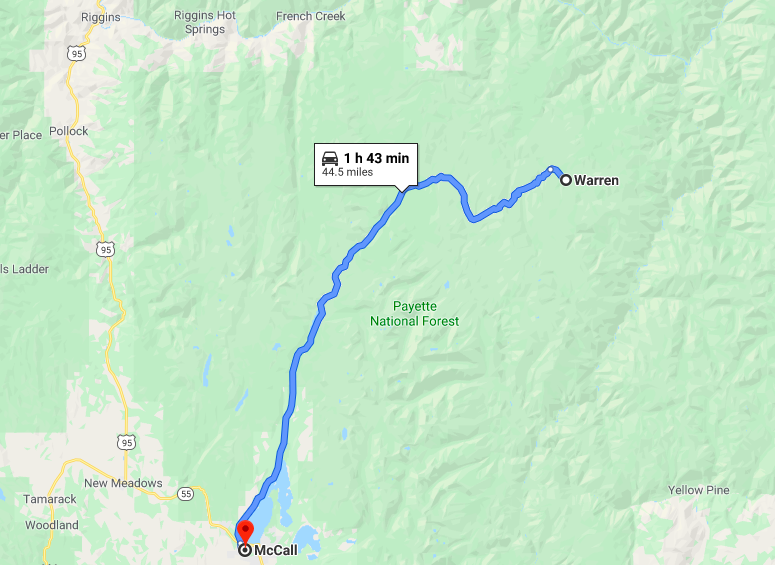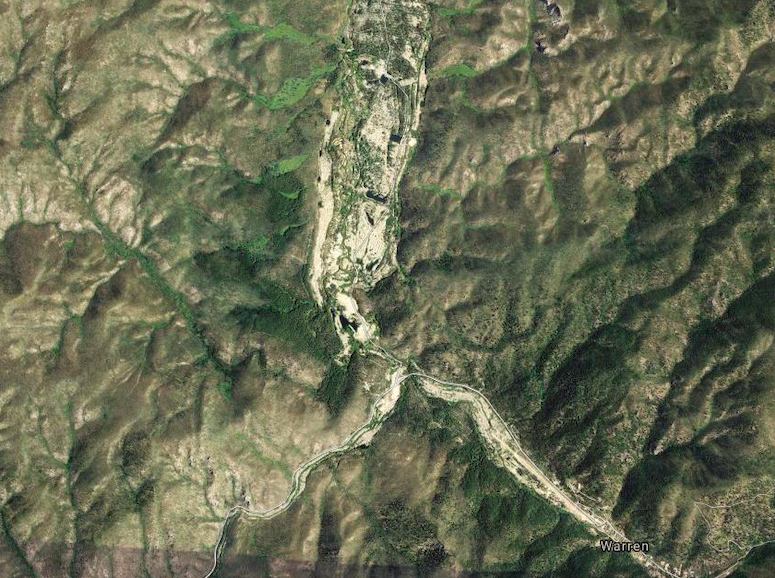
The central Idaho mountains enjoyed a rich history of gold mining. This remote area is brimming with gold and other precious minerals. In the 1860s, gold was discovered in several areas in the Salmon River Wilderness that led to substantial mining booms.
One such event occurred at Warren, and for a short time it was one of the largest mining camps in Idaho.
Today it is a relatively easy drive to get to from McCall via the Warren Wagon Road, but when gold was first discovered in 1862 this area was as remote as they come.
A prospector named James Warren led the effort, and the town was named after him, originally called as Warren’s Diggings. Warren marked one of the earliest mining cites in Idaho, and the legacy of gold mining has been thriving for more than 150 years. Warren boosted extensive and rich deposits of gold, and the summer of 1862 witnessed scores of miners amassing massive fortunes.
It Starts with the Gold Placers
During the very first year of mining, estimates reveal more than two million dollars’ worth of gold was extracted from the Warren district. The placers of Warren were certainly rich, but they were also expansive gravels that covered many miles along Warren Meadow.
This was in stark contrast to the placer deposits of in Florence on the north side of the Salmon River, who’s placers were shallow and mined out quickly. It was apparent that the placer deposits in Warren would sustain mining activity for many years.
Some of the early reports claimed that men were recovering as much as 75-ounces of gold per day using rocker boxes along Steamboat Creek and Warren Creek.
The deep gold-bearing gravels continued to sustain miners for many seasons, and even when word of the Boise Basin Gold Rush made it to Warren, many of the miners were content to stay and continue mining in Warren.
Development of Hard Rock Properties
In those first few seasons, most miners were content placer mining the creeks in the Warren area. But many began to surmise that the gold that had accumulated in Warren Meadow was likely sourced from veins in the surrounding mountains. Since all of the good ground on the creeks were now claimed up, prospectors began searching for hard rock sources.
Throughout the 1860s and 1870s, load mines across the Warren area witnessed a slow-paced period of development, with many gold deposits being effectively mined. The remoteness of the camp would hamper the growth of these mines, but slowly they grew and many came into operation during this time.
For decades, Warren experienced a culture of hard rock mining, which continued long after the easiest placer deposits were worked out. The quartz mines operated day and night, and were active even in the winter when the placer mining was at a stand still.
Over the course of a decade there were 9 different auriferous quartz veins identified and worked in the Warren area. Numerous mines came into operation, the largest being the Charity Mine and Rescue Mine. Their ores produced both gold and silver that were very high-grade.
Safe and Stable Mining Community
Warren rose to fame as one of the well-developed and organized gold mining camps in Idaho, which was a striking comparison to the lawless and disorderly reputation of nearby Florence. Warren began attracting thousands of fortune hunters and miners as it continued to evolve as a civilized and orderly gold mining site.
Historical references reveal that the founders of Warren originally hailed from Florence and devoted their efforts to the construction of a town that provided miners a safe, peaceful and inclusive community.
Warren’s gold placers were largely worked out towards the end of the 1860s, and by 1870 a sizable Chinese population had moved in to work these abandoned claims. The Chinese immigrants were willing to rework the areas that were now being ignored by the white miners. Even these so-called “mined out” claims would still produce some gold, and they paid enough to attract Chinese who were struggling harsh conditions back in their home country.
From the 1870s to 1900, Chinese formed a clear ethnic majority across the district, and Warren enjoyed the reputation of being a mining camp that welcomed Chinese with its inclusive environment. Most other camps throughout the West regarded the Chinese with disdain and did not allow them a welcoming environment.
Warren Wagon Road

Even today, getting to Warren is no small feat! From McCall, head north on the Warren Wagon Road. This is remote country, so be sure to bring plenty of supplies with you on your trip.
Like The majority of the remote mining towns and districts across Idaho, the major challenge faced by the miners in Warren was the lack of efficient transportation and freight facilities. The 1890s witnessed the construction of the town’s first wagon road, and this allowed all the supplies and gold to be hauled by pack train.
Winter brought a heavy spell of snow, which made freighting extremely challenging, bringing all transportation networks to a halt. The miners and townspeople were forced to stock up sufficient supplies to last all winter. Winters in Warren were marked with tough times, and the residents relied on rationing to survive the chilly season.
The Warren Wagon Road is still the main access to Warren even today. From McCall, it follows along the west side of Payette Lake, then along the Secesh River and eventually drops down into Warren.
The 1904 Fire
The 1904 fire brought immense destruction to the town of Warren, and majority of the business districts and retail outlets were burned to the ground. However, even four decades after gold was first discovered in Warren the town managed to quickly recover and underwent significant efforts of rebuilding and renovation.
These efforts speak volumes about the massive quantity and superior quality of gold ores discovered in mining fields across the district.
Dredging on Warren Creek

This aerial photo shows the miles and miles of dredge tailings throughout Warren Meadows. Three huge dredges churned up the deep gravels and recovered lots of gold. Operations were ceased during World War 2 when the mining of all non-essential metals was halted.
1931 witnessed a striking change in mining practices and the overall scale of mining activities. The arrival of a bucket line dredge completely altered this culture as miners could now work the deep gravels across the year. The dredge proved to be an excellent method, and by 1932, three dredges were active in Warren, with a fourth one made operation by 1934.
During the 1930s, Warren’s dredging success made it one of the leading producer of gold across the state. While the entire country was engulfed in the throngs of the Great Depression, Warren’s economy witnessed a miraculous stability.
In 1942, Warren’s dredge industry met with a disastrous blow when World War 2 began, and gold mining activities across the US were brought to a halt. The events that followed marked the end of mining in Warren.
Also Read: Montana’s Huge Bucket Gold Dredges (9 Historic Images)
Lots of Visitors & Still a Few Miners
Warren enjoys a community filled with retirees and residents who enjoy the quaint and peaceful atmosphere of a sleepy town. This is still a remote town, but it gets a lot of visitors in the summer, and is a popular area for snowmobilers in the winter time.
The dredges are long gone and the sound of stamp mills no longer fill the mountains, but there is still gold here. Despite decades of mining in Warren, a person can still recover a little bit of gold if you pan the gravels along the creek. Driving into town you will be surrounded with dredge tailing piles on each side of the road. The signs of historic mining will be all around you.
Additional Reading:
A Recent Visit to the Yankee Fork Dredge
12 of the Richest Gold Mining Locations in Idaho

